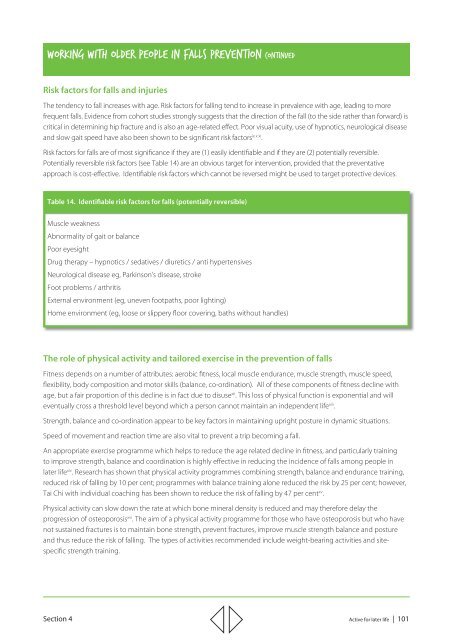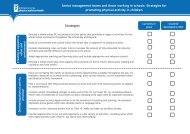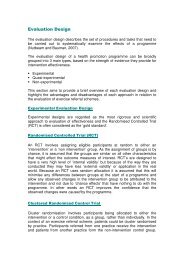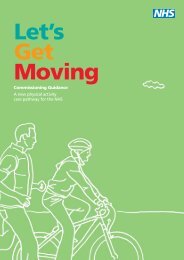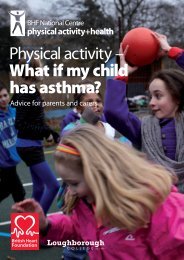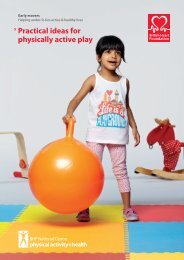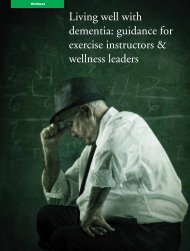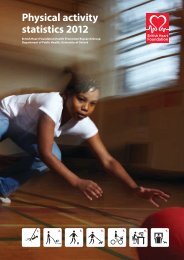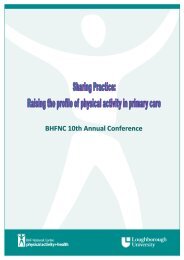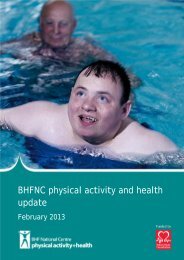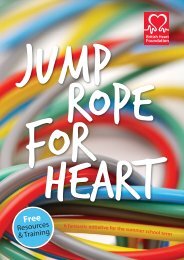Working papers - BHF National Centre - physical activity + health
Working papers - BHF National Centre - physical activity + health
Working papers - BHF National Centre - physical activity + health
You also want an ePaper? Increase the reach of your titles
YUMPU automatically turns print PDFs into web optimized ePapers that Google loves.
<strong>Working</strong> with older people in falls prevention CONTINUED<br />
Risk factors for falls and injuries<br />
The tendency to fall increases with age. Risk factors for falling tend to increase in prevalence with age, leading to more<br />
frequent falls. Evidence from cohort studies strongly suggests that the direction of the fall (to the side rather than forward) is<br />
critical in determining hip fracture and is also an age-related effect. Poor visual acuity, use of hypnotics, neurological disease<br />
and slow gait speed have also been shown to be significant risk factors ix x xi .<br />
Risk factors for falls are of most significance if they are (1) easily identifiable and if they are (2) potentially reversible.<br />
Potentially reversible risk factors (see Table 14) are an obvious target for intervention, provided that the preventative<br />
approach is cost-effective. Identifiable risk factors which cannot be reversed might be used to target protective devices.<br />
Table 14. Identifiable risk factors for falls (potentially reversible)<br />
Muscle weakness<br />
Abnormality of gait or balance<br />
Poor eyesight<br />
Drug therapy – hypnotics / sedatives / diuretics / anti hypertensives<br />
Neurological disease eg, Parkinson’s disease, stroke<br />
Foot problems / arthritis<br />
External environment (eg, uneven footpaths, poor lighting)<br />
Home environment (eg, loose or slippery floor covering, baths without handles)<br />
The role of <strong>physical</strong> <strong>activity</strong> and tailored exercise in the prevention of falls<br />
Fitness depends on a number of attributes: aerobic fitness, local muscle endurance, muscle strength, muscle speed,<br />
flexibility, body composition and motor skills (balance, co-ordination). All of these components of fitness decline with<br />
age, but a fair proportion of this decline is in fact due to disuse xii . This loss of <strong>physical</strong> function is exponential and will<br />
eventually cross a threshold level beyond which a person cannot maintain an independent life xiii .<br />
Strength, balance and co-ordination appear to be key factors in maintaining upright posture in dynamic situations.<br />
Speed of movement and reaction time are also vital to prevent a trip becoming a fall.<br />
An appropriate exercise programme which helps to reduce the age related decline in fitness, and particularly training<br />
to improve strength, balance and coordination is highly effective in reducing the incidence of falls among people in<br />
later life xiv . Research has shown that <strong>physical</strong> <strong>activity</strong> programmes combining strength, balance and endurance training,<br />
reduced risk of falling by 10 per cent; programmes with balance training alone reduced the risk by 25 per cent; however,<br />
Tai Chi with individual coaching has been shown to reduce the risk of falling by 47 per cent xv .<br />
Physical <strong>activity</strong> can slow down the rate at which bone mineral density is reduced and may therefore delay the<br />
progression of osteoporosis xvi . The aim of a <strong>physical</strong> <strong>activity</strong> programme for those who have osteoporosis but who have<br />
not sustained fractures is to maintain bone strength, prevent fractures, improve muscle strength balance and posture<br />
and thus reduce the risk of falling. The types of activities recommended include weight-bearing activities and sitespecific<br />
strength training.<br />
Section 4 Active for later life | 101


